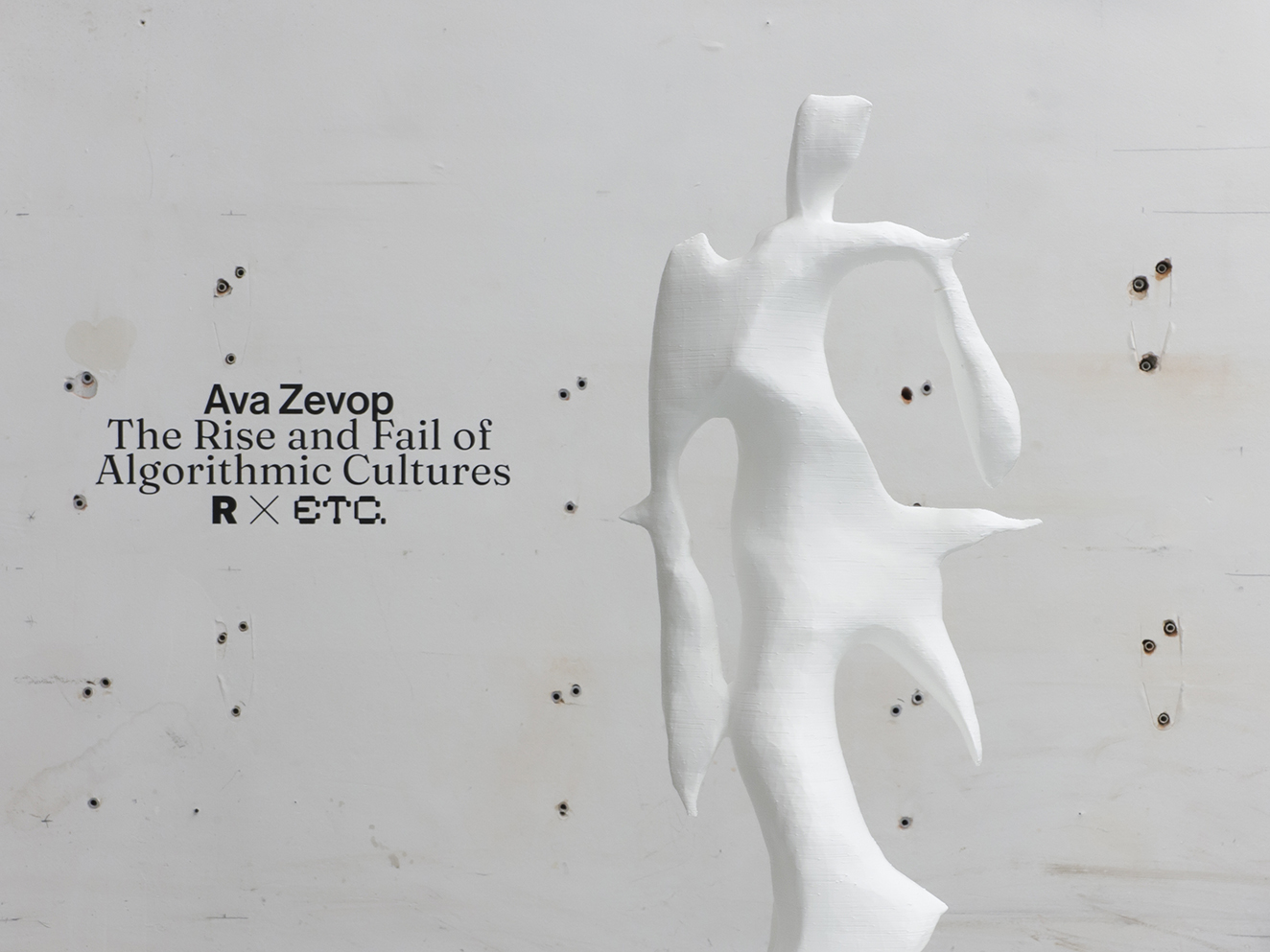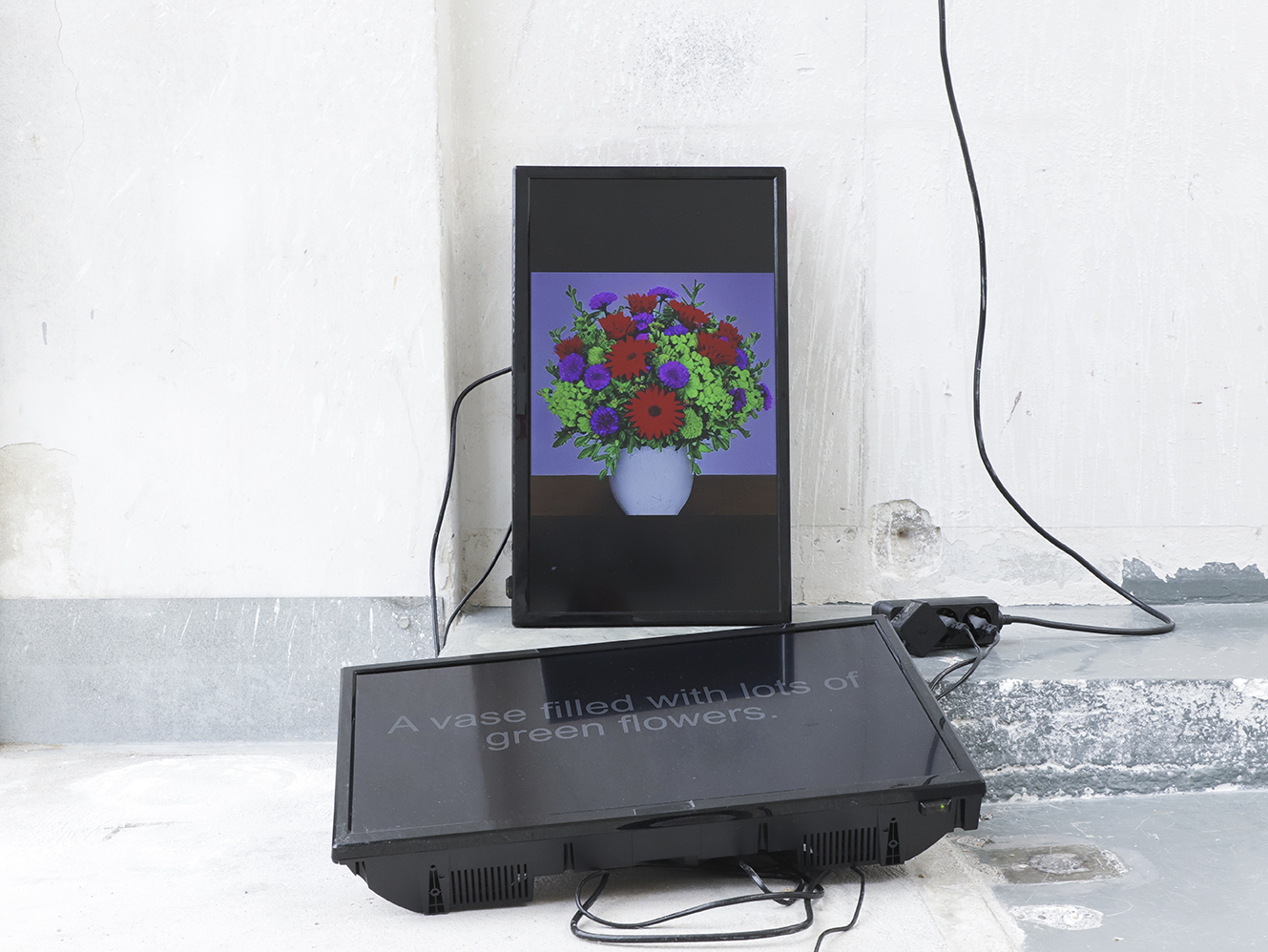AVA ZEVOP
The Rise and Fail of Algorithmic Cultures
September 15 —
November 12, 2023
The Rise and Fail of Algorithmic Cultures
September 15 —
November 12, 2023
LOCATIONRAVNIKAR GALLERY
Vošnjakova ulica 4
1000 Ljubljana
Vošnjakova ulica 4
1000 Ljubljana
CURATOR
Curated by ETC.
Curated by ETC.
PHOTOGRAPHERMario Zupanov
︎︎︎STATEMENT
Visual and intermedia artist Ava Zevop examines synthetic media as a new mode of cultural production, while questioning the insertion of computation into the fields of epistemology and the everyday. The Rise and Fail of Algorithmic Cultures is an interweaving of the artist's past projects and research that foregrounds the influence of different (mainly Western) cultural contexts on the construction of databases, the role of algorithms in generating images, and the resulting successes and failures of artificial intelligence.
The sculptures in the exhibition are generated using a machine learning model that draws on the art historical database ScanTheWorld, a database of three-dimensional scans of various artefacts. The objects on display in the basement room were generated in the process of learning, and therefore also reveal errors, while the two sculptures on display on the ground floor are from the generative space, when the learning process is supposed to have been completed. The duality of the sculptures' display thus reveals the course of such processes, which follow the path of existing and established ways of including and excluding in art collections, while at the same time displaying a completely abstract, alien logic inherent in the "reason" of the computational space itself.
The processes of generating images and text from different databases are also highlighted in Real-time and Noise. The cue for the work Real-time is the live action that the camera is capturing, which triggers the automated generation of text at first and a new image in the second step. There can thus be a lot of common ground between the action in space, the textual and the pictorial interpretation, but there can also be a reading that is foreign to the human gaze or a representation that does not match our expectations. The work Noise also represents a kind of communication, a chain of generation and retrieval of images collected in databases. The trigger here is a random arrangement of pixels (noise), which is read and reinterpreted in the next step as a generated image. In the third step, an existing visual is retrieved from the COCO database, which is expected to be the most similar to the previously generated one. COCO is one of the earlier and more widely used image recognition training databases, first created in 2014 (and regularly updated since), that includes images from earlier Internet, echoing its commercialisation and the widespread use of digital cameras. The search in Noise seems to have taken place on a formal, abstract level, as the similarities between the generated and found visuals are formal rather than semantic. However, it is precisely what escapes the semantic level of interpretation that interests the artist most in the process described, since it is clear that beneath the layer of what is visible and what is subject to human understanding, meaning is made in a different way, alien to us.
The Rise and Fail of Algorithmic Cultures highlights the ambivalence of machine learning models and their dependence on older epistemologies and categorisations, as well as on computational logic itself. The works in the exhibition are linked by the idea of the materialisation of a computational space, a space of learning, errors, interpretations, visualisations, and the creation of a new logic of automated processes that we can attempt to understand, but which also escapes us, or that we imagine we understand more than we actually do.
*
The works Noise and Real-Time were produced by Ljudmila, Art and Science Laboratory, as part of the project In the Beginning was Static ... in the End a Woven World (2022). The 3D-printed sculpture models were created as part of the project Webbed Wide Worlds (2023), produced by Ljudmila, Art and Science Laboratory.
Supported by Jakopič Gallery, Museum for design and architecture MAO. Thanks to Benjamin Fele, Elias Heuninck (Formlab, School of Art Ghent).
︎︎︎ABOUT THE ARTIST
Ava Zevop is a visual and intermedia artist whose interests lie in the intersections between technology, matter, thought, and sociality. She is currently exploring the material, epistemological, and computational foundations of emerging digital culture. Her work has been exhibited, among others, in the group exhibition Fever Dream at Kresija Gallery (2023), in the solo exhibitions In the Beginning, There Was Static ... In the End, There Was the Webbed Wide World (2022) and Webbed Wide Worlds (2023) at osmo/za, at Design FEST Gent in the Design Museum Gent (2022), in the group exhibition Let it be Queer! in the City Gallery of Ljubljana (2021), and Infrastructural Complex: Altered Earth at the 26th International Festival of Computer Art – MFRU (2020). Ava lives and works between Ljubljana and Brussels.
Vizualna in intermedijska umetnica Ava Zevop preučuje sintetične medije kot nov način kulturne produkcije ter se hkrati sprašuje o vnosu komputacije v polja epistemologije in vsakdanjega. Razstava The Rise and Fail of Algorithmic Cultures predstavlja preplet umetničinih preteklih projektov in raziskovanj, ki v ospredje postavljajo vpliv različnih (predvsem zahodnih) kulturnih kontekstov na izgradnje podatkovnih baz, vlogo algoritmov pri generiranju podob ter posledično uspehe in neuspehe umetne inteligence.
Skulpture na razstavi so generirane na podlagi modela za strojno učenje, ki črpa iz umetnostnozgodovinske podatkovne baze tridimenzionalnih skenov različnih artefaktov ScanTheWorld. V kletnem prostoru razstavljeni objekti izhajajo še iz postopka učenja, zato razkrivajo tudi napake v procesu, medtem ko sta uspeli skulpturi, na ogled v pritličju, iz generativnega prostora, ko naj bi bilo učenje že zaključeno. Dvojnost prikaza skulptur tako razkriva potek tovrstnih procesov, ki stopajo po poti obstoječih in uveljavljenih načinov vključevanja ter izključevanja prisotnega v zbirkah umetnosti, obenem pa se v njih kaže povsem abstraktna, tuja logika, lastna “razumu” komputacijskega prostora samega.
Procese generiranja podob in besedil na podlagi različnih podatkovnih baz izpostavljata tudi deli Real-time in Noise. Iztočnica za delo Real-time je dogajanje, ki ga kamera spremlja v živo in pomeni povod za avtomatizirano generiranje sprva besedila in v drugem koraku nove podobe. Med dogajanjem v prostoru, tekstovno in slikovno interpretacijo je tako lahko veliko skupnega, lahko pa pride do branja, ki je tuje človeškemu pogledu ali upodobitve, ki se ne sklada z našimi pričakovanji. Tudi Noise predstavlja svojevrstno komunikacijo in verigo generiranja ter iskanja podob, zbranih v podatkovnih bazah. Povod je tukaj naključna razporeditev pikslov (noise), ki je prebrana in v naslednjem koraku reinterpretirana kot generirana podoba. V tretjem koraku pa je iz podatkovne baze COCO poiskana obstoječa vizualija, ki naj bi bila prej generirani najbolj podobna. COCO je ena zgodnejših in široko uporabljenih baz za treniranje prepoznave slik, ki je bila prvič ustvarjena leta 2014 (ter kasneje večkrat posodobljena) in vključuje podobe zgodnejšega interneta, v njej pa odmeva tudi njegova komercializacija ter razširjena raba digitalnih fotoaparatov. Zdi se, da je iskanje v delu Noise potekalo na formalni, abstraktni ravni, saj so podobnosti med generiranimi in najdenimi vizualijami prej oblikovne kakor semantične. Prav tisto, kar uhaja semantični ravni interpretacije, pa je tisto, kar umetnico v opisanem postopku najbolj zanima, saj je jasno, da se pod plastjo vidnega in tistega, kar je podvreženo človeškemu razumevanju, smisel ustvarja drugače, nam tuje.
Razstava The Rise and Fail of Algorithmic Cultures izpostavlja ambivalentnost modelov strojnega učenja in odvisnost le-teh od starejših epistemologij ter kategorizacij pa tudi od same računalniške logike. Dela na razstavi povezuje ideja materializacije komputacijskega prostora, prostora učenja, napak, interpretacij, vizualizacij in ustvarjanja nove logike avtomatiziranih procesov, ki jo lahko poskušamo razumeti, a nam sproti tudi uhaja ali pa si domišljamo, da razumemo več, kot nam je v resnici znanega.
*
Deli Noise in Real-Time sta nastali v produkciji Društva Ljudmila, laboratorija za znanost in umetnost, v okviru projekta Na začetku je bila statika … na koncu spleteni svet (2022). Modeli 3D-tiskanih skulptur so bili ustvarjeni v okviru projekta Širni spleteni svetovi (2023) v produkciji Društva Ljudmile, laboratorija za znanost in umetnost.
Podpora: Galerija Jakopič, Muzej za oblikovanje in arhitekturo
Zahvala: Benjamin Fele, Elias Heuninck (Formlab, School of Arts Ghent)
Ava Zevop je vizualna in intermedijska umetnica, katere interesi ležijo v presečiščih med tehnologijo, materijo, mišljenjem in družbenostjo. Trenutno raziskuje materialne, epistemološke in komputacijske temelje novonastajajoče digitalne kulture. Njena dela so bila med drugim predstavljena na skupinski razstavi Fever Dream v Galeriji Kresija (2023), v okviru samostojnih razstav Na začetku je bila statika ... na koncu spleteni svet (2022) in Širni spleteni svetovi (2023) v osmo/zi , na festivalu Design FEST Gent v Muzeju oblikovanja Gent (2022), na skupinski razstavi Let it be Queer! v Mestni galeriji Ljubljana (2021) in na 26. mednarodnem festivalu računalniške umetnosti – MFRU: Infrastrukturni kompleks: Altered Earth (2020). Ava živi in deluje med Ljubljano in Brusljem.
︎︎︎INSTALLATION VIEWS











